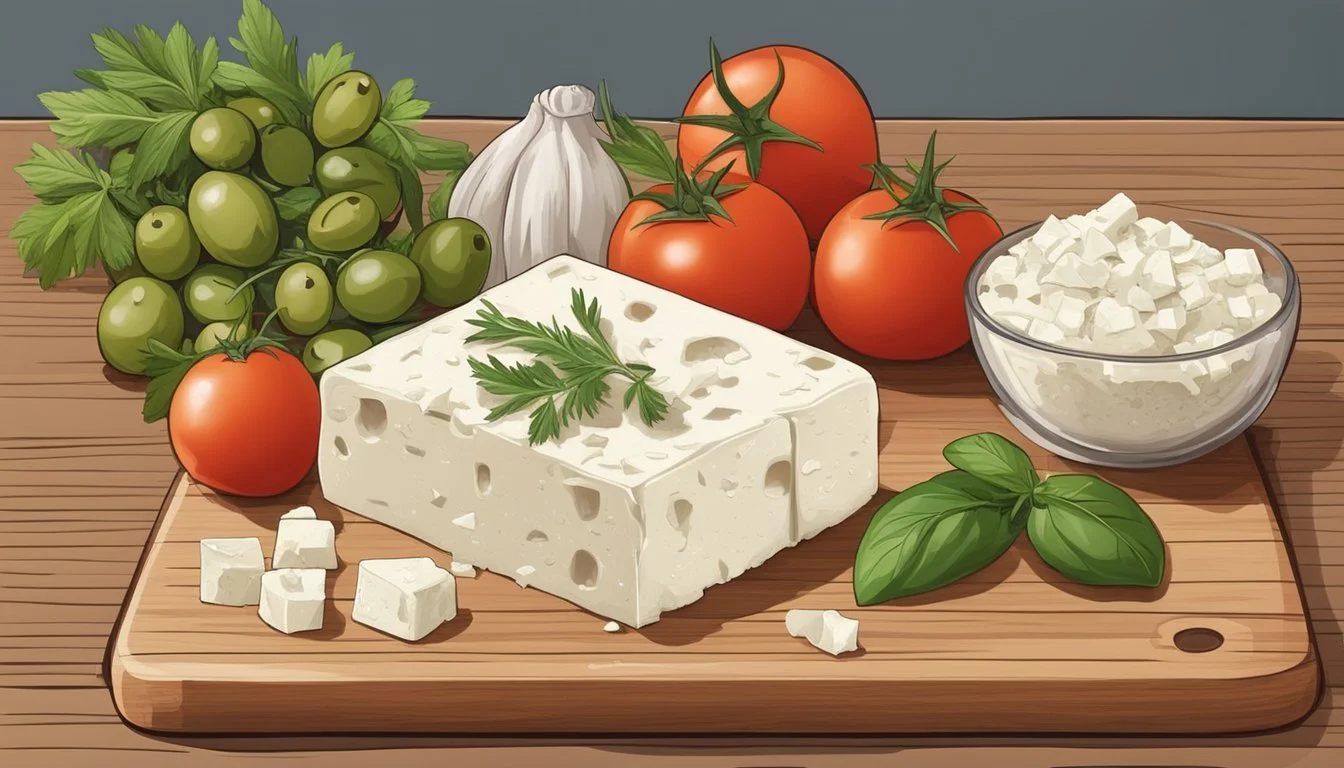Feta Cheese Substitutes
Top Alternatives for Your Recipes
Feta cheese (What wine goes well with cheese?) is known for its crumbly texture and tangy, salty flavor, a staple in Greek cuisine that has found its way into kitchens around the world. Its unique taste and versatility make it a beloved ingredient in salads (What wine goes well with salads?), pastries, and many savory dishes. However, whether due to dietary restrictions or unavailability, people often look for substitutes that can mimic or provide a similar impact to feta cheese in their cooking.
A variety of options exist for those seeking an alternative to feta cheese. Dairy substitutes like labneh offer a creamy, tangy element with a thick texture ideal for spreading or dipping. Cotija cheese, with its comparably salty and crumbly attributes, serves as a fantastic stand-in, especially in Mexican dishes. Ricotta, another alternative, brings a sweeter taste and higher moisture content, serving well in contexts where a milder cheese is called for.
Non-dairy options can also serve as suitable replacements when a plant-based or vegan substitution is desired. Nutritional yeast, when combined with raw cashews or almonds, can be crafted into a tangy, vegan-friendly feta alternative. Various condiments and other ingredients, like capers, (What wine goes well with capers?) hummus, or avocado, offer their distinct flavors and textures, providing unique substitutes that still fulfill the role of feta cheese in many dishes.
The Basics of Feta Cheese
Feta cheese is a distinct variety known for its bold tangy and salty flavor profile, with a texture that ranges from creamy to crumbly. This section explores its origins, taste, texture, and the diverse culinary contexts in which feta is utilized.
Origins and Taste Profile
Originating in Greece, feta cheese is a staple in Mediterranean cuisine. It comes with a pronounced tangy and salty taste that is instantly recognizable. Classically made from sheep's milk, or a mixture of sheep's and goat's milk, feta carries a geo-protected status in the European Union, meaning that only cheese produced in specific areas of Greece can be labeled as "feta."
Texture and Culinary Uses
Texturally, feta can be soft and creamy or firm and crumbly, making it highly versatile in cooking. It is typically sold packed in brine, which helps preserve its signature texture and taste. Chefs incorporate feta into a variety of Mediterranean dishes, from fresh Greek salads to baked spanakopita and feta pasta. The cheese's structure allows it to be easily crumbled over salads, such as the classic Greek salad, or incorporated into dough for a savory pastry filling.
Dairy-Based Feta Alternatives
When considering dairy-based alternatives to feta cheese, one should prioritize options that offer a similar tangy flavor and crumbly texture. These alternatives can work excellently in salads, baked dishes, and as part of a cheese platter.
Halloumi Cheese
Halloumi cheese, with its semi-hard texture and salty taste, can withstand high temperatures without melting. It's an ideal option for grilling or frying.
Cottage Cheese
Cottage cheese's texture is creamier than feta, but its mild flavor allows it to blend well in recipes. Its lower fat content also makes it a healthier choice for those conscious about their fat intake.
Ricotta and Ricotta Salata
Ricotta's soft consistency and subtle sweetness can replace feta in dishes that require a less tangy taste. Ricotta Salata, a firmer and salted version of ricotta, can be crumbled similarly to feta.
Mozzarella and Mozzarella Cheese
Fresh mozzarella, known for its moisture and delicacy, can serve as a feta substitute in terms of texture. Dry Mozzarella Cheese, with less moisture, works better for baking.
Gorgonzola and Blue Cheese
Both Gorgonzola and other blue cheeses possess a potent flavor profile. They can serve as feta substitutes to add a strong, piquant kick to salads and dips.
Parmesan
Grated parmesan offers a saltiness and granular texture. It's suitable for sprinkling over dishes as an alternative to feta, especially when a nuttier taste is preferred.
Cotija and Queso Fresco
Cotija cheese, though slightly harder, has a similar saltiness to feta. On the other hand, Queso Fresco is milder with a softer texture, beneficial for those seeking a gentler replacement.
By choosing any of these dairy-based alternatives, enthusiasts can maintain the character of their dishes without compromising on taste or texture.
Non-Dairy and Vegan Feta Substitutes
For those avoiding dairy or following a vegan lifestyle, a variety of non-dairy and vegan feta substitutes are available. These alternatives replicate the tangy taste and crumbly texture of traditional feta cheese and are ideal for salads, baking, and spreads.
Nut-Based Cheeses
Nut-based cheeses, particularly those made from almonds and cashews, stand out as creamy and versatile feta substitutes. Almond cheese offers a firmer consistency, while cashew cheese has a creamier texture. To make these at home, you'll need:
1 cup raw almonds or cashews, soaked and drained
2 tablespoons nutritional yeast for a cheesy flavor
Lemon juice, to taste
Combine these ingredients, blend until smooth, and season to replicate the distinct taste of feta cheese.
Tofu-Based Feta
Tofu-based feta is an excellent vegan substitute for its dairy counterpart, having a similar appearance and texture. Made from soy, tofu is lactose-free and carries a mild taste. Enhancing its flavor to mimic feta involves:
Pressing tofu to remove excess moisture
Crumbling it to obtain the desired consistency
Adding lemon juice and nutritional yeast for tanginess
Seasoning with salt, herbs, and spices to enhance taste
Commercial Vegan Feta
For those seeking convenience, commercial vegan feta cheese options are available in many health food stores. These products typically blend various plant-based ingredients to achieve a taste and texture resembling traditional feta. They are suitable for both Mediterranean and non-Mediterranean dishes, providing a dairy-free alternative without the need for preparation.
Nutritional Yeast Flakes
Nutritional yeast flakes are a staple in vegan cooking, often added to non-dairy substitutes for feta cheese to introduce a cheesy, umami flavor. They are rich in B vitamins and can be sprinkled over salads or mixed into vegan cheese bases to enhance the feta-like experience. Nutritional yeast is integral to the flavor profile of most homemade and commercial vegan feta cheeses.
Health Considerations of Substitutes
When considering substitutes for feta cheese, it's important to assess their nutritional content, potential allergens, and suitability for various dietary restrictions to make informed choices based on individual health requirements.
Nutritional Content Comparison
The nutritional content of cheese substitutes can vary widely. For example, Labneh is lower in fat than feta and provides a suitable calcium and protein content, but may have higher sodium levels. Halloumi shares a similar protein profile to feta and provides calcium but is also high in fat and sodium. Vegan cheese alternatives, like those made from cashews or almonds, are rich in healthy fats, protein, and vitamins such as E, but may lack in calcium and phosphorus when compared to feta. A direct comparison of nutritional values per serving is as follows:
Substitute Protein Calcium Sodium Iron Phosphorus Vitamins Labneh Medium High High Low Medium B-vitamins Halloumi High High High Low High B-vitamins Nut-based Medium Medium Low High Medium E
Allergen Information
Substitutes such as nut-based cheeses present possible allergen concerns, particularly for individuals with tree nut allergies. Dairy-based substitutes like Labneh and Halloumi contain lactose, posing potential issues for those with lactose intolerance. It's crucial that individuals with allergies read labels carefully to avoid adverse reactions.
Dietary Restrictions
Dietary restrictions play a significant role in cheese substitute selection. Labneh and Halloumi may not be suitable for vegan diets due to their dairy content. Conversely, nut-based substitutions cater to vegan requirements but may not be appropriate for those following low-fat or nut-free diets. One should also consider whether the cheese alternative is compatible with a low-sodium diet, as many cheese substitutes, particularly dairy options, can be high in sodium.
Culinary Applications of Feta Substitutes
Feta cheese substitutes come into play when one seeks replication or variation of its salty and tangy taste profile in Mediterranean dishes and other culinary creations without using the traditional feta cheese.
Salads and Cold Dishes
In salads and cold dishes, one should opt for cheese that offers a soothing contrast yet maintains a similar crumbly texture. Labneh, with its creamy consistency, can gracefully replace feta, especially in Greek salads or as a topping over chilled roasted vegetables. Ricotta can also work as a milder, less fatty option.
Baked Dishes and Pizzas
For baked dishes and pizzas, the ideal substitutes are those that can endure heat without losing their character. Cotija cheese, due to its strong flavor and crumbly texture, excels as a topping on Mediterranean pizzas. In spanakopita, a drier cheese like aged ricotta might be used, maintaining the desired flaky and savoury profile.
Wraps and Burgers
When one substitutes feta in wraps or burgers, the goal is to mimic feta's ability to add a salty punch. One can use Gorgonzola as a flavorful stand-in that melts well, enhancing the flavor of a gyro or a vegetable burger without overpowering the other ingredients.
Stir-Fries and Omelettes
In stir-fries and omelettes, feta cheese often contributes a tangy flavor that can be matched by using nutritional yeast and cashews or almonds when crafting a vegan substitute. This combination brings a nutty, cheesy flavor to omelettes or can elevate the taste profile of a simple vegetable stir-fry.





